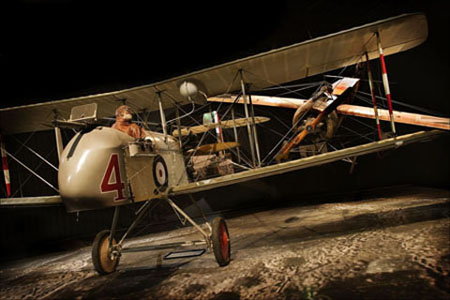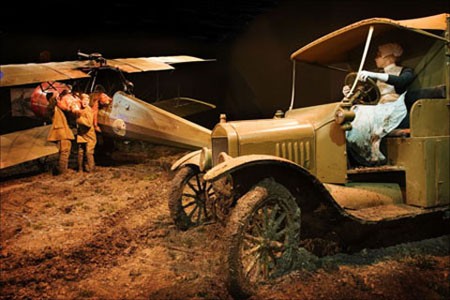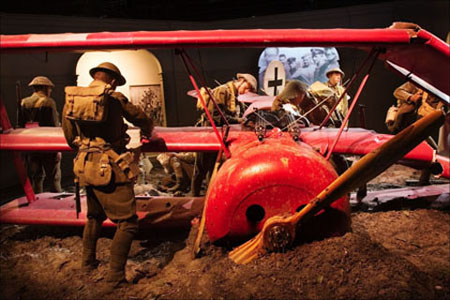
New Zealand's Marlborough region, in the extreme north-east of the south island, attracts visitors keen on the wineries of the Wairau Plain and in outdoor pursuits around the nearby mountain lakes. Marlborough now also draws visitors more interested in spending a couple of hours in a darkened over-sized tin shed: the Omaka Aviation Heritage Centre. Opened in December 2006, Omaka, located a few kilometres west of Blenheim, the region's commercial hub, has become its single most significant tourist attraction. Omaka's publicity declares it to be 'the best museum in the world', an encomium drawn from a 2007 Sydney Morning Herald travel blog; of which more presently. This review explores that claim, asking whether it is justifiable, and what being a museum necessarily entails: indeed, is Omaka a museum?
Aviation has been a part of the Wairau Plain since the early 1920s, when Captain Euan Dickson touched down in a paddock at Dillons Point, just east of Blenheim. By the time Charles Kingsford Smith landed at nearby Woodbourne on his first trans-Tasman flight in 1928, a flying club was operating from a strip 5 kilometres from Omaka. The strips at Omaka and Woodbourne became Royal New Zealand Air Force stations during the Second World War. Omaka reverted to a minor airstrip until in the first decade of the twenty-first century it became the focus of the Omaka Aviation Heritage Trust. A happy combination of aviation enthusiasts, a collection of aeroplanes and a wealthy, passionate champion (in filmmaker Peter Jackson) has resulted in Omaka becoming the home of a striking and significant historical display.
We need to be clear about what Omaka is and is not. Despite its advertising slogan, it is not a 'collection', nor a 'museum' as defined by the International Council of Museums. Of the 16 or so aircraft on display (the actual number varies) only two, a Caproni CA22 and a de Havilland DH4, are 'original'. The rest are replicas, constructed long after the First World War, some very recently. Some of the replicas are, to be sure, extremely rare in themselves — the Moraine-Saulnier fighter is 'the world's sole intact example', and the DH5 fighter is 'the only flying example in existence'. Still, Omaka sits more comfortably within the paradigm of 'interpretive centre' rather than 'museum'. It is a place that re-creates the things of the past rather than displaying real things from that past.
'Authenticity' is a crucial but vexed idea at Omaka. When it launched an advertising campaign in 2007 to entice Wellingtonians to cross Cook Strait and visit, it did so in a characteristically clever media stunt. It engaged the help of New Zealand's pigeon-racing fraternity and had 289 pigeons carry 289 small pieces of a billboard from Marlborough to Wellington (http://www.youtube.com/watch?v=K8TOQPdWqxk). As the pigeons delivered their messages, men dressed as Great War soldiers pasted the segments into place. The billboard's most prominent word was 'authentic'. Ironically, the key message chosen to promote this collection of replicas was that it represented an 'authentic' experience. Surely 'authenticity' implies the real? Surely replicas can at best only be 'evocative'?
Regardless of this reservation, Omaka is a truly extraordinary phenomenon. It currently occupies a 60-metre square hangar on what looks like — and what is — a country aerodrome, one more accustomed to crop-dusters and recreational flying than replica Great War biplanes. Though unprepossessing externally, Omaka's visual wealth becomes apparent on entering the hangar, Omaka's inaugural display, Knights of the Sky, comprises the world's largest collection of First World War replica aircraft, many of them in flying condition, all displayed in a series of striking tableaux.
Visitors move at their own pace past a series of what are actually life-size 'set pieces' — not 'dioramas', because they are not perspective models — each based around one or sometimes two replica aircraft, each including one or up to half-a-dozen or more realistically posed and clothed figures.
Several of these set pieces justify more detailed discussion. Omaka's creators have obviously striven to escape from the convention that sees historic aircraft displayed sitting on the ground on their tail-skids, devoid of life and action. By contrast, most of Omaka's replicas are canted or angled, some in attitudes suggesting flight or (in the case of Grid Caldwell's SE5a) imminent crash.
The set pieces were produced mainly with the creative talent of New Zealand's Weta workshop — the acclaimed and award-winning creative artists behind films such as the Lord of the Rings trilogy, King Kong and District 9, all coordinated and partly funded by Peter Jackson. Their standard of animation, dressing and realism is outstanding, and in several instances make historical points superbly. In the Etrich Taube and Albatross B.II displays the placement and stance of the aviators inject an impressive sense of life and movement into the scene. (Indeed, the aircraft, real and replica, displayed at Omaka without figures — the Caproni, Halberstadt, Nieuport 24 and DH5 — look as lifeless as aircraft displayed in any other aviation museum.) In contrast, the drama of the riggers helping to carry a wounded pilot out of the bullet-pocked Morane-Saulnier (with the observer lifeless in his bloodstained cockpit) conveys a powerful message about the reality of air combat.
Some of the figures can be criticised. For example, the armourers in the Breguet set piece wear brand-spanking new uniforms and shoulder-flashes — these clothes have never been handled by men with oily fingers. The nurse in the Morane-Saulnier set piece is driving the Ford ambulance — an unrealistic scenario for nurses of the period. But overall, the standard ranks with any comparable presentations in the world, and as Omaka features a dozen such displays it must be regarded as outstanding by any measure.

Sometimes Omaka's set pieces aim for sensation over historical accuracy. The second-largest set piece depicts a British pilot being captured after escaping death when his Nieuport 27 crashes into a tree in a wintry landscape. The pilot of a German Siemens-Schuckert DIV has landed beside the stricken Nieuport to claim his captive. (According to an Omaka voluntary guide the display is based on an actual incident, when the captured British flyer was feted by his captors.) The effects of the plane caught in the tree's boughs, the snow-covered scenery and the figures (each with their tracks carefully impressed into realistic-looking snow) are highly evocative. But a visitor who takes the trouble to read the accompanying interpretative panel will notice that the DIV entered service only in August 1918. As the war ended in November, can it be strictly true that the German aviator flew a Siemens-Schuckert in winter? The answer, provided by an obliging, but anonymous Omaka staff-member, is that the scene uses 'artistic licence'.
Omaka's largest set piece, located in the centre of the building, is its most impressive and complex. It depicts Australian troops taking souvenirs from the red Fokker triplane in which Baron Manfred von Richthofen was killed on 21 April 1918. They are shown taking items from the downed aircraft, cutting panels out of the plane's fabric covering and even stripping Richthofen's fur boots from his body — it implicitly shows why so much of Richthofen's aircraft and personal kit is in collections across the world. Several of the actual items, among the hundreds of pieces taken from the plane, are displayed in an adjacent showcase. (One curiosity — immediately apparent to anyone with a passing familiarity with Australian uniform in the First World War — is the question why the Australian figures lack any colour patches indicating the units to which they belonged.) The scene is, however, notable among such set pieces in that it depicts the dead body of Richthofen and an act of looting, scenes usually taboo in war museums. This is praiseworthy: despite the romanticism of its Knights of the Sky rubric, Omaka actually presents the aftermath of combat as squalid — the rapacity of the Australians in looting the aircraft and Richthofen's body is discomforting. This is historical interpretation of a high and subtle standard, far in advance of the approach of some larger, officially sponsored museums, whose attitude is far more respectful and, indeed, timid.

While the set pieces largely speak for themselves in communicating the essence of the danger and daring of the air war, Omaka is content to allow the sheer technical brilliance of the replicas and the scenes they inhabit to convey meaning. Despite the spirited animation of the figures and the inherent drama of several of the set pieces, they allow the technical to prevail over the human. For example, high on a wall beside the changing display of replica Fokker triplanes is a large and telling photograph of Werner Voss, one of the Imperial German Air Service's Jewish fighter aces. In a photograph taken days before Voss was killed in action in 1918, he looks much older than his 20 years, with bags under his eyes, exhausted by the physical and mental strain of flying in action. But the air war's emotional burden is almost entirely unstated: the novelty of Omaka's theatricality becomes a substitute for the substance that could so readily be introduced by judicious captioning highlighting the human costs of the air war.
The display at Omaka is in two parts. The most visible are the set pieces, but in the centre of the hall is a display of aviation memorabilia. In contrast to the replicas, virtually all of this material — exhibited in several crowded and poorly lit showcases — is original. Omaka's website lists some of its 'highlights', including the flying suit worn by the American 'ace' Eddie Rickenbacker, Max Immelmann's pocket watch, Ernst Udet's 'Blue Max' (the Pour le Mérite, Germany's highest gallantry award) and various aircraft insignia including one from the Lafayette Escadrille, the American-French volunteer squadron. It is notable that many of the highlights relate to well-known air aces, one of the few aspects of the display that reinforces its title, Knights of the Sky.
The display of artefacts is frustratingly rich. It includes dozens of items that would seem interesting — if only they were arranged, lit and captioned so they could be seen and understood. Many of these items truly are of world-class importance in documenting and interpreting the First World War in the air. Omaka's website observes that 'a visitor can spend a few minutes or several hours captivated by the richness and significance of this exhibition' — but most visitors (as I observed) spent only a minute or two peering into poorly lit and arranged cases, attempting to read captions in shade before giving up and moving on to the more brightly lit set pieces. Fortunately, later advice from Omaka's director, Jane Orphan, is that the memorabilia displays are being extended, thinned out and re-captioned.
However, praise for Omaka must also be qualified in one, albeit crucial area relating directly to the idea of interpretation, both in sight and sound. While Omaka's set pieces are superb, cleverly conceived and skilfully realised, their explanation is less thorough than one might expect. Curiously, for a centre created by 'creatives' spinning off the film industry, there is little use of film and and almost no accompanying sound in the displays. While silent films accompany three set pieces, the centre's 'multi-media' presentations are in fact 'mono-media' displays. There is not even the sound of the engines of the aircraft displayed, even though Omaka of all places has the means to record this noise. In developing the Second World War gallery at the Australian War Memorial, opened in 1999, we went to considerable trouble to obtain a recording of a Spitfire (displayed in the gallery on a pylon) which periodically roared 'across' the gallery using speakers placed above visitors' heads. Omaka has no recordings of either aircraft or machine guns; a curious omission.
Interpretative centres need to interpret, not just by presenting set pieces, but by explaining them adequately. Traditionally this is conveyed using graphic panels. Omaka's panels provide minimal contextual information. They deal with the aircraft on display, their introduction, technical specifications and operational history. While the SE5a depicting 'Grid's escape' is accompanied by panels describing the career of Keith Grid, most set pieces are actually unexplained. Even those dealing with specific incidents, such as the crashed Nieuport 27 in the snow, do not tell the story of what is shown.
The standard of Omaka's labelling does not match that of either its replicas or the set pieces. The panels are carelessly written and expressed, aimed mainly at buffs looking for technical specifications and details rather than at non-specialist visitors seeking to understand what it is they are looking at. Howlers of one sort and another abound — 'who's' for 'whose', 'flow' confused for 'flown', a 'gunnery unit' rather than an 'artillery battery' and, most ludicrously, a reference to an 'Achilles heal'. Omaka's creators seem more at home with the look of the thing than with the careful use of words to explain what it is that they have created.
But Bruce Elder, the writer of the Sydney Morning Herald travel blog, was right to be impressed with Omaka's displays. Posing the question in his heading, 'The best Museum in the World?' he answers with a resounding affirmative. However, it is for us to consider exactly what he meant. As a travel journalist (an occupation more inclined to puffery than rigorous analysis) Elder intended to convey that here was a place that gave visitors immediate entrée to a historical experience — the air war of the Great War — using stuff (aircraft, mannequins and backdrops) that they can respond to emotionally, to learn from almost subliminally. That the set pieces do not contain any 'authentic' material was to Elder irrelevant. In the jargon of the museum industry, however, Omaka is more correctly regarded as an 'interpretive centre'. There are many such centres in Britain devoted to wars and battles (at Bosworth, Bannockburn or Culloden), in Europe (at Thiepval on the Somme) or in the United States (many Civil War battlefields have visitor centres that display more replicas or reconstructions than original items). All of these interpretive centres communicate knowledge and insight into profound human experiences; but none of them are 'museums' as that term is generally used. Omaka has more in common with these interpretative centres than it does with aviation museums such as the Smithsonian Air and Space Museum or the Royal Air Force Museum, Hendon.
Shortcomings such as the display of original material and the quality of its graphic panels aside, however, Omaka substantially remains an extraordinary and admirable achievement. The skill and creativity that it has devoted to its replicas and the set pieces in which they are displayed are indeed of world standard.
But is this 'the best museum in the world'? Omaka can reasonably be regarded as 'one of the best historical interpretive centres', perhaps even 'in the world', given the way it unites machines with figures in animated settings, created with exceptional creativity and superb craftsmanship. While 'one of the best historical interpretive centres in the world' isn't nearly as catchy as 'the best museum in the world', it is more justified.
|
Exhibition: |
Knights of the Sky |
|
Institution: |
Omaka Aviation Heritage Centre |
|
Curatorial team: |
Jane Orphan, museum staff and volunteers, external contractors, including Weta Workshop |
|
Venue/dates: |
Omaka Aviation Heritage Centre, ongoing |
